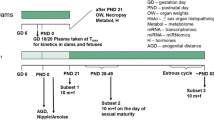Abstract
The synthetic oestrogen hexoestol is hepatotoxic to the female rat. Twenty-five animals were treated daily with hexoestrol at a dose of 60 mg/kg. Twenty-five more acted as controls. Five animals from each group were killed after 4, 12, 20, 30 and 40 days of treatment to permit serial evaluations of liver histopathology to complement serum biochemical investigations.
There were no mortalities during the study and only modest external signs of toxicity. All the treated rats showed reductions in body weight and appetite and gains in liver weight. This latter effect was due to both cellular hypertrophy and hyperplasia.
The principle finding of the liver histopathology was fatty change. This affected scattered individual cells, mainly in the midzonal region.
All of the serum parameters of toxicity — which consisted of bilirubin, total protein, albumin, glycoprotein, α2-macrofoetoprotein, and alkaline phosphatase — indicated liver impairment. Most of these also showed time-related changes consistent with an initial phase up to Day 20 of marked liver dysfunction superseded by a more adaptive phase thereafter.
The hepatotoxicity described here seems sufficient to explain blood clotting defects observed elsewhere in oestrogen-treated rats.
Similar content being viewed by others
References
Beller FK, Ebert C (1985) Effects of oral contraceptives on blood coagulation. Obstet Gynecol Surv 40: 425–436
Cooper EH, Ward AM (1979) Acute phase reactant proteins as aids monitoring disease. Invest Cell Pathol 2: 293–301
Culling CFA (1974) Handbook of Histopathological and histochemical techniques. 3rd ed. Butterworths, London
Gibson JP, Newberne JW, Kuhn WL, Elsea JR (1967) Comparative chronic toxicity of three oral estrogens in rats. Toxicol Appl Pharmacol 11: 489–510
Gool J van, Ladiges NC (1969) Production of foetal globulin after injury in rat and man. J Pathol 97: 115
Gopinath C, Rombout PJ, van Versendaal RG (1978) Serum alkaline phosphatase elevation in female rats treated with ethinyl estradiol. Toxicology 10: 91–102
Gumicio JJ, Valdevieso VD (1971) Studies on the mechanism of the ethynylestradiol impairment of bile flow and bile salt excretion in the rat. Gastroenterology 61: 339–344
Hart JE, Loscombe SM, Hall DE, Parke DV (1979) The effect of oestrogens on blood clotting in the rat. Thromb Haemostas 42: 1069–1070
Heywood R, Wadsworth PF (1980) Experimental toxicology of estrogens. Pharmacol Ther 8: 125–142
Imai K, Heyashi Y (1970) Steroid-induced intrahepatic cholestasis in mice. Jpn J Pharmacol 20: 473–481
Keyser JW (1979) Human plasma proteins. John Wiley, Chichester
Kohn J, Whicher J, Warren C, O'Kelly T (1980) The use of lectins to measure acute phase proteins in the serum and plasma of man and animals during inflammation and tissue breakdown. FEBS Lett 109: 257–260
Korte W, Brenner G (1963) Degeneration und Nekrose in Leber und Niere der Ratte nach Zufuhr hoher Dosen von Oestradiol-17β und Oestriol. Endokrinologie 45: 253
La Via MF, Hill RB (1971) Principles of pathology. Oxford University Press, London
Loeser A (1939) Pharmacology and toxicology of synthetic estrogens (4,4′-dihydroxy-α, β-diethylstilbene). Z Gesamte Exp Med 105: 430–446
Mancini G, Carbonara AO, Heremans JF (1965) Immunochemical quantitation of antigens by single radial immunodiffusion. Immunochemistry, 2: 235–254
Plaa GL, Priestly BG (1976) Intrahepatic cholestasis induced by drugs and chemicals. Pharmacol Rev 28: 207–273
Realini JP, Goldzieher JW (1985) Oral contraceptives and cardiovascular disease; a critique of epidemeliogic studies. Am J Obstet Gynecol 152: 729–798
Schulte-Hermann R (1974) Induction of liver growth by xenobiotic compounds and other stimuli. CRC Crit Rev Toxicol September, 97–158
Teague RS (1942) Toxicology of the synthetic estrogen diethylstilbestrol and certain related compounds. J Pharmacol 75: 145–153
Warren C, Whicher J, Kohn J (1980) The use of concanavalin A to measure acute phase proteins by laser nephelometry. J Immunol Methods 32: 141–150
Westerholm B (1980) Clinical toxicology of estrogens. Pharmacol Ther 10: 337–349
Author information
Authors and Affiliations
Rights and permissions
About this article
Cite this article
Hart, J. Hepatotoxicity of the synthetic oestrogen hexoestrol in the female rat. Arch Toxicol 59, 216–220 (1986). https://doi.org/10.1007/BF00290541
Received:
Accepted:
Issue Date:
DOI: https://doi.org/10.1007/BF00290541



